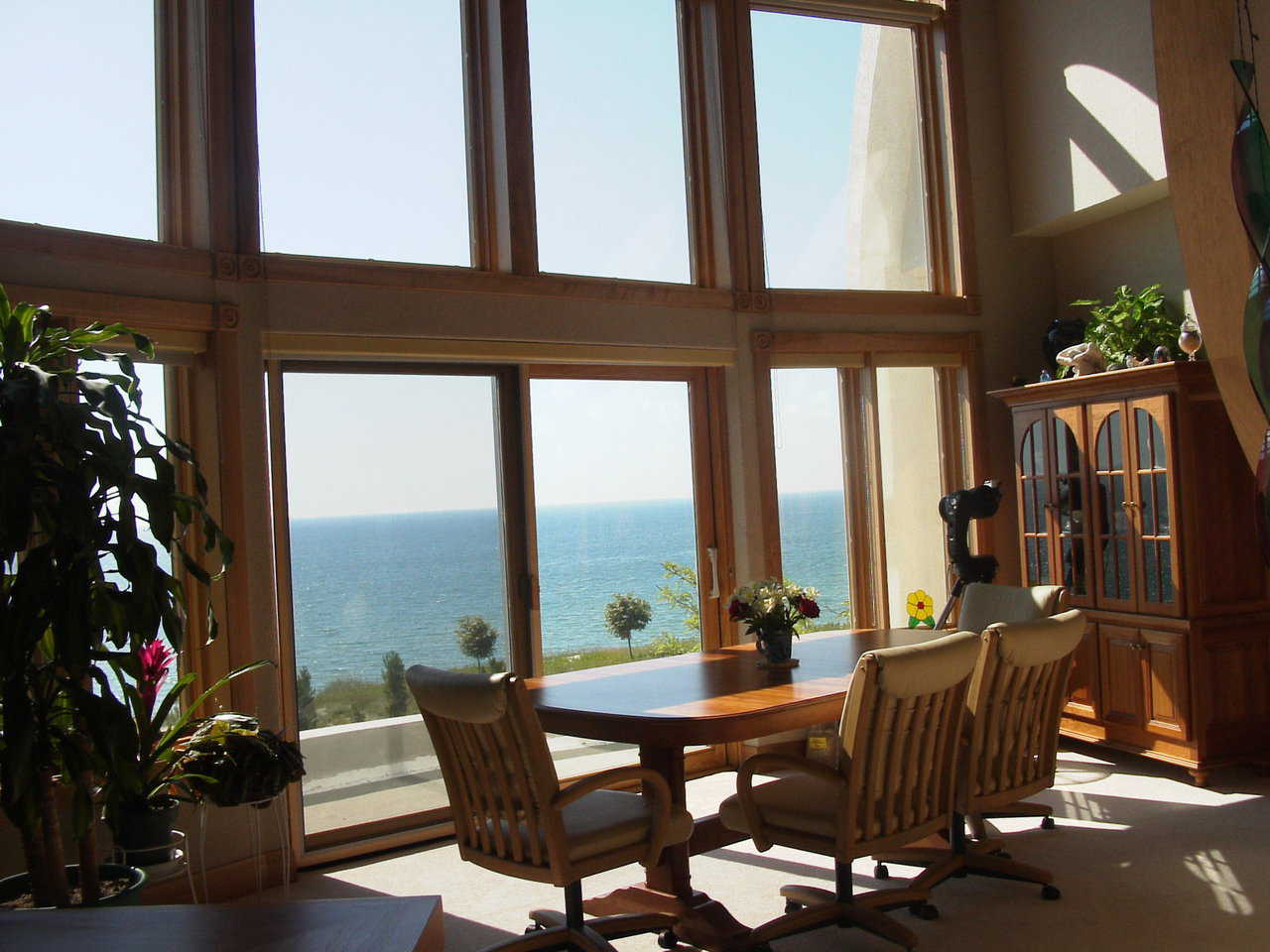Can a Monolithic Dome home that is three stories high and that has a diameter of 55 feet just disappear? Almost — if it’s built on a bluff overlooking Lake Michigan in Manitowoc, Wisconsin and if it’s painted a pale blue and if a fog creeps up that bluff. Barbara Stitt, who together with husband Paul own this dream-come-true Monolithic Dome home, said, “On a slightly foggy day, the house just about disappears, which is what we wanted.” The Stitts achieved that effect by choosing just the right shade of blue paint for the outside of their Airform.
Wisconsin’s first Monolithic Dome
Besides the ability to almost disappear, this dome is unique in other ways. It’s Wisconsin’s first and, as such, it created quite a stir in Manitowoc, a city populated by about 35,000.
Manitowoc, whose name means “home of the great spirit,” abounds in colorful sites and historic structures, including the Kresge Building that from 1929 to 1986 had both a five-and-dime store and a 25-cent store with a wall separating the two. Nevertheless, the Stitt’s dome brought media attention and more than 500 curious visitors to their open house. “We had invited only about a 100 people to see the dome, but word just spread, and they all came,” Barbara said. “Many commented about the quiet and the spaciousness of the dome.”
Located on a 1.7-acre site, this home’s three stories provide 4000 square feet of living space. Its lowest level encompasses two garages and a housekeeper’s apartment of 1500 square feet. The main or middle floor includes a spacious, curved living room; kitchen; dining room; guest bedroom and bath; storage and laundry areas. On the dome’s highest level, the Stitts have their master bedroom, his and her bathrooms and walk-in closets, an enclosed sun room where Barbara plans to grow orchids and a small balcony off the workout area.
The plan
The Stitts, who own and operate Natural Ovens Bakery, first became interested in domes after a stay at a Mexican resort built in the round. Barbara said, “Some time later, as it came closer to building our house, our son showed us a video on Monolithic Domes.” They were immediately intrigued, but decided that they really needed to go in and see the inside of a Monolithic Dome home, so the Stitts visited the Eye of the Storm." Once we were in that space, there was no turning back. We made our decision," Barbara said. But another four years passed in planning and working out the details before construction began. In August 2002, they finally moved into their dream home.
The design
The Stitts contacted Robert Bissett of Naples, Idaho whose expertise includes structural design and architecture as well as portrait painting and sculpting. Robert said, “I visited the site and began design in December of 1998, and the final design was arrived at in July of 2001. It was a team effort. My attitude is that the client is the visionary, not the designer.”
So Barbara and Robert worked on the dome’s design and some of its exterior and interior details together. She said, “Robert just did an excellent job. He and I just really honed in on things and pretty much finished them out.”
Major problem resolved on site
During the planning stage, several different designs for the Stitt’s dome were drawn and sent to Barbara and Paul for their consideration — and that inadvertently created a mistake that could have spelled major disaster. Apparently, when ordering the Airform, the wrong drawings had been consulted, resulting in an Airform that had the proper diameter but not height. It was a whopping three feet too short! Dan Sutterfield discovered the problem when he inflated the Airform. Dan immediately called Robert Bissett, and together they figured out how the mistake happened.
But now what? How do you resolve it? Ordering a new Airform would be extremely costly in both time and money. And shipping the Airform back to the factory for alterations wasn’t that economical either.
David South came up with a practical, least-expensive solution. He chartered a plane that flew two of Monolithic’s Airform experts, Gary Clark and Don Garrison, along with the additional Airform fabric and necessary tools to Manitowoc.
Gary said, "Before we ever got started, Don prepared the fabric that needed to be seamed to the Airform so that it could be added quickly. We also had a machine that would seal the fabric. When we got there, we were pleased to find that Dan and his crew had the Airform deflated and waiting for us.
“They did not have the floor poured in that building, but they had a wide footing,” Gary continued. “That gave us a flat surface, all the way around, to work on. Then it was just a matter of getting the machine all hooked up and the fabric lined up the way it needed to be.”
Gary and Don cut the Airform and added the three-foot skirt. The entire process took seven hours. But before leaving, Gary and Don had Dan re-inflate the Airform to make sure that it looked and was right. To everyone’s relief, it was.
“The best part of that job,” Gary said, “was getting a nice loaf of that delicious Natural Ovens bread to take with us and eat on the flight back.”
The shell construction
Dan Sutterfield of Sutterfield Services, LLC in Newburg, Missouri said that he will never forget the inflation of the Stitts’ Airform because, “We did it on 9-11-2001!” Barbara remembers it, as well as the rest of the construction process. She said, “Dan did the shell, and he did a very nice job. That structure will be there for an awfully long time.”
The interior and exterior finishing
For the finishing, the Stitts called Stan Johnson, a local general contractor and vice president of ACE Building Service, Inc. Since ACE had built additions at the Manitowoc facility for Natural Ovens Bakery, Stan and the Stitts had a time-proven relationship. Stan said, “We usually don’t do residential. We do mostly industrial and commercial, but this was very interesting. It was a project and a half. It got us working with vendors and suppliers we don’t typically deal with, so we had to develop relationships along the way. Stuff like that was a challenge.”
Stan had not heard of Monolithic Domes prior to the Stitt home. Asked what he thought about the Monolithic process, Stan said, “The dome itself was unique. But once that’s completed, it’s standard construction on the inside.” He said that although it was a little more difficult to lay out, they had no problem working in the round, and they really enjoyed the project.
Special features and touches
Barbara carefully planned and selected every detail and accouterment for each of the dome’s rooms. She said, “I worked about a year and a half getting it the way we wanted it. There’s only one thing that I wouldn’t put in and it’s not a big deal. We have a chute used for dropping recyclables like plastics and papers into a closet in the garage, and I would not do that again. That was a waste of time and money.”
Natural woods
The Stitts used five natural woods in their dome. Out of one — hickory — Paul and Barbara commissioned Archway Staircase in Appleton, WI to do a sweeping stairway from the main floor to the third level. She said, “It’s incredibly gorgeous and so well balanced. When they moved it into the room, before they connected it, it stood by itself, and you could actually walk up part of the way.” In addition to the stairway, hickory adorns the elevator that serves all three levels.
Other natural woods include oak for Paul’s bathroom; cherry throughout the kitchen, dining and living rooms; birch window and door trimmings; and maple for the first floor apartment. Barbara also designed a massive, cherry-wood headboard for the master bedroom.
Acoustic wallpaper
To absorb echoes, the Stitts installed seamless acoustic ceiling tiles and acoustic wallpaper manufactured by Muraspec, generally for commercial, not residential, use. Barbara said, “I think that the acoustic wallpaper is just the crowning touch because our ceiling over the dining room area goes up to the third floor. Without that acoustic wallpaper, there would be an echo, but everybody comments on the quiet.” The pattern Barbara chose (Cascade) has a fabriclike, ribbed texture that Barbara’s grandson describes as “cuddly.”
A coating for the Airform
The Stitts researched various Airform coatings and decided to use Sealmark Restoration Coating in a pale blue color. According to Sealmark’s website, their Restoration Coating protects exteriors from UV rays and environmental exposure and has the ability to expand and waterproof. Barbara said, “This material really sealed the windows. When they got that coating around the windows — because it expands about 500% without cracking — it really did a good job.”
Outdoor stairway
At the end of a circular driveway, a curved, concrete stairway leads from the ground level to the main entrance on the second floor. Barbara said, “It’s wonderful — very comfortable stairs to go up and down. We have railings that are done of stainless steel so there’s never any rust, and they’re just pieces of art. They bowl out, so it kind of gives the feeling of a ship.”
Limestone skirting
A gray-blue Valders limestone from a quarry in Valders, WI — just 10 miles west of Manitowoc — skirts the base of the dome. The quarry claims that Valders limestone is one of the hardest, most durable stones on earth and that it resists chemical and physical attack from pollutants and erosion.
Life in the disappearing dome
“We love it every second of every day that we’re here,” Barbara said. “We can sit in the living room and see the sun rise throughout the day and into the sunset. It’s stunning and the dome is just gorgeous.”
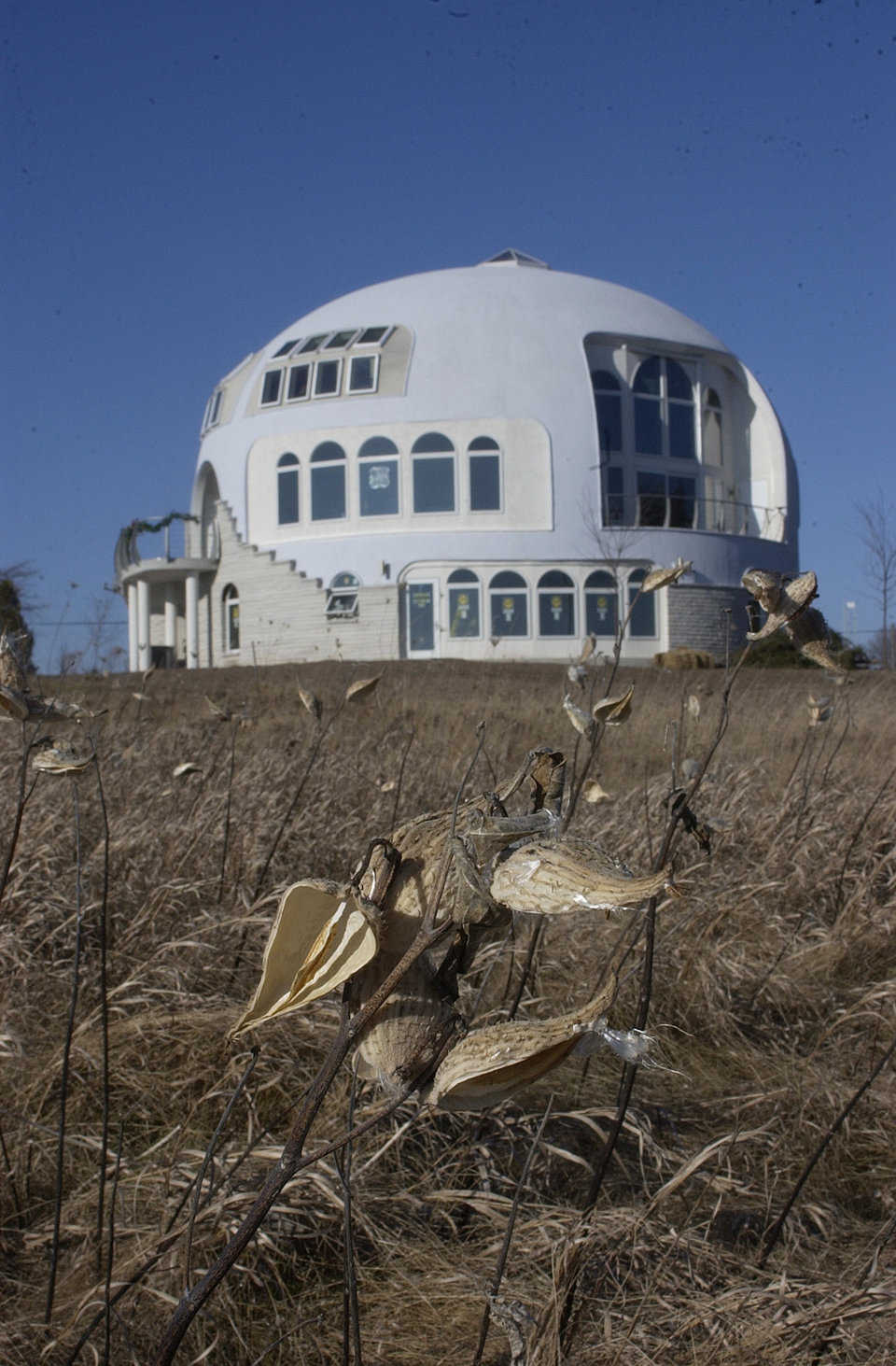
The Disappearing Dome — This dream-come-true home in Manitowoc, Wisconsin is a Monolithic Dome with a diameter of 55 feet and three stories. It overlooks Lake Michigan and on foggy days because almost invisible.
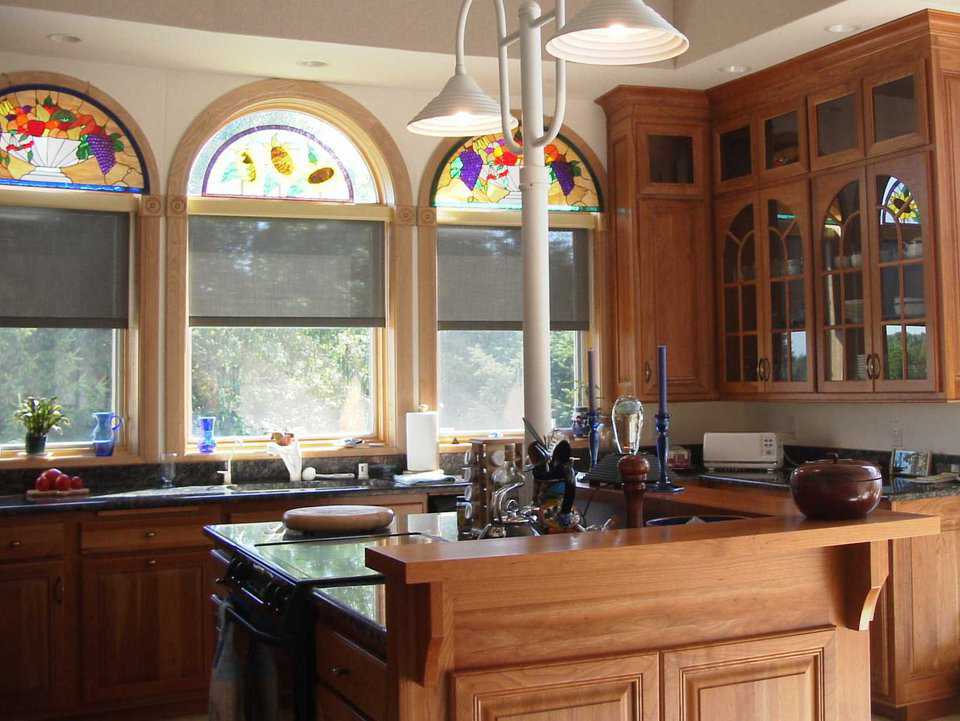
Gourmet Fittings — The kitchen features custom cabinets and stained-glass windows.
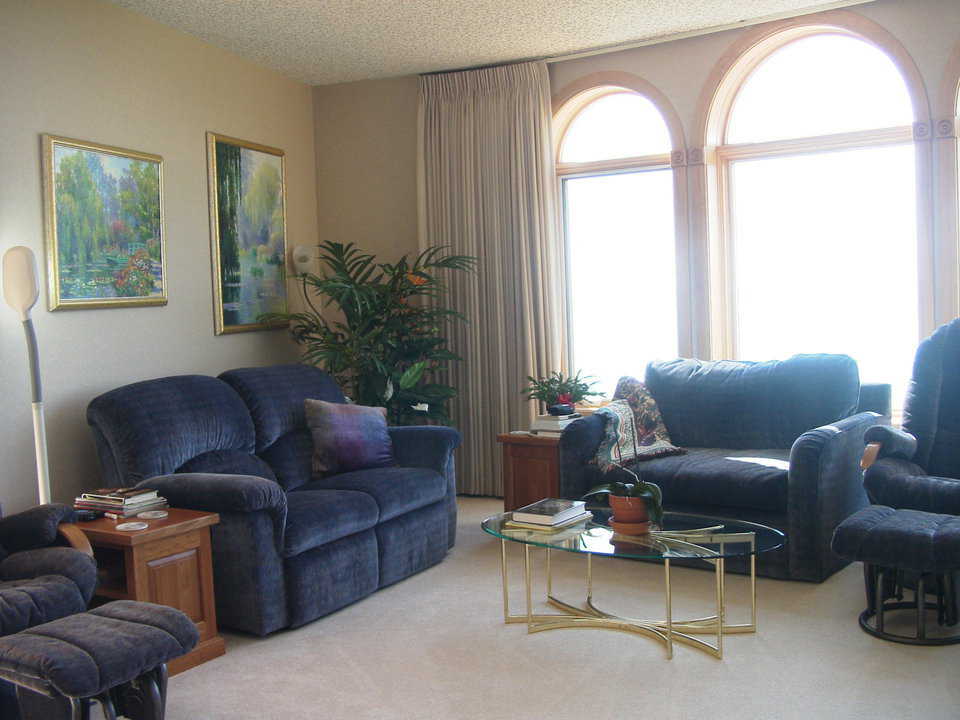
Living Room — Arched window panes over the large living room windows complement the round shape of the dome.
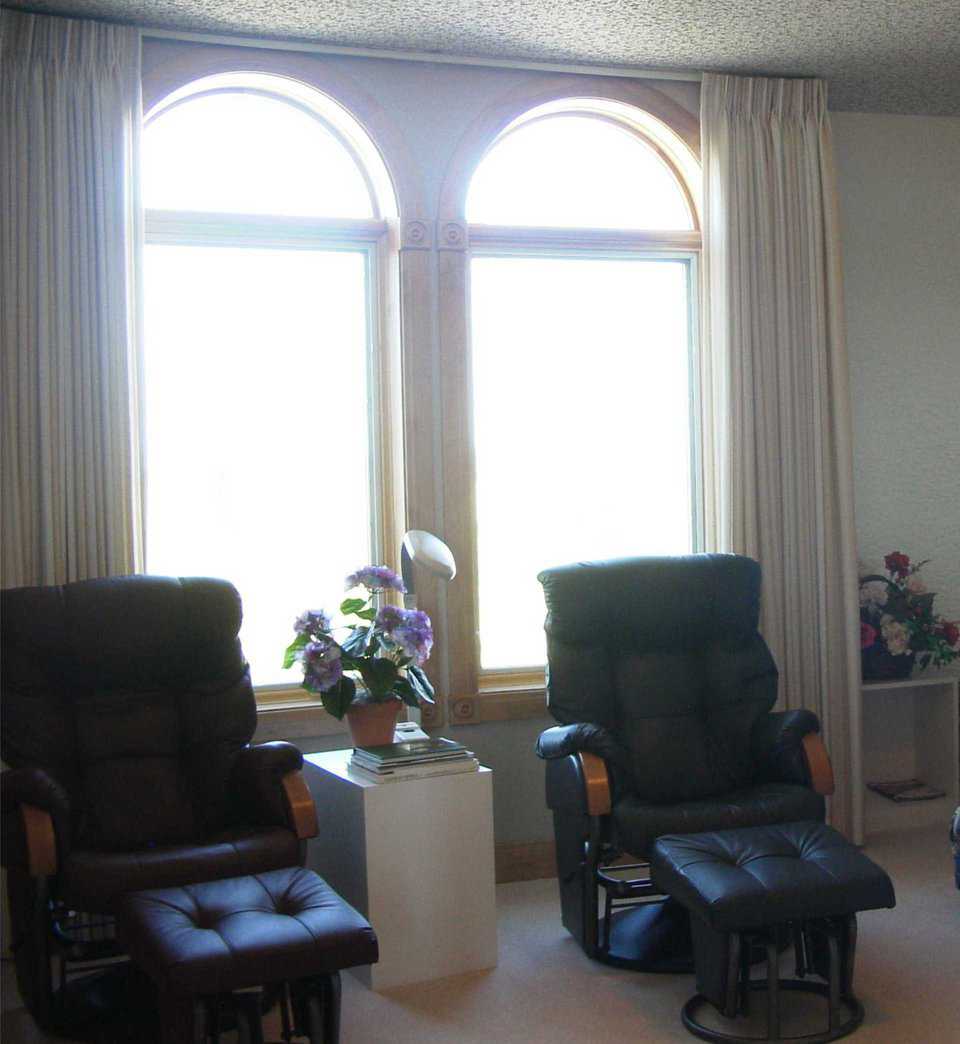
Furnished for Comfort — Furnishings in this bedroom include a queen bed and comfy, cozy recliners.
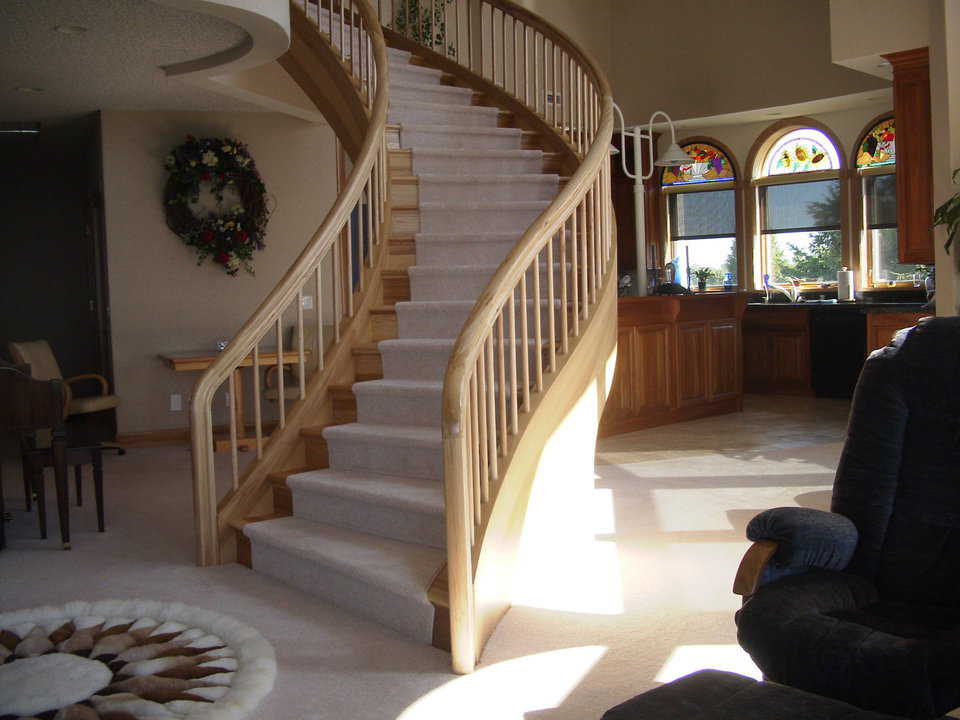
Custom Stairway — A graceful, winding stairway leads to the second floor.
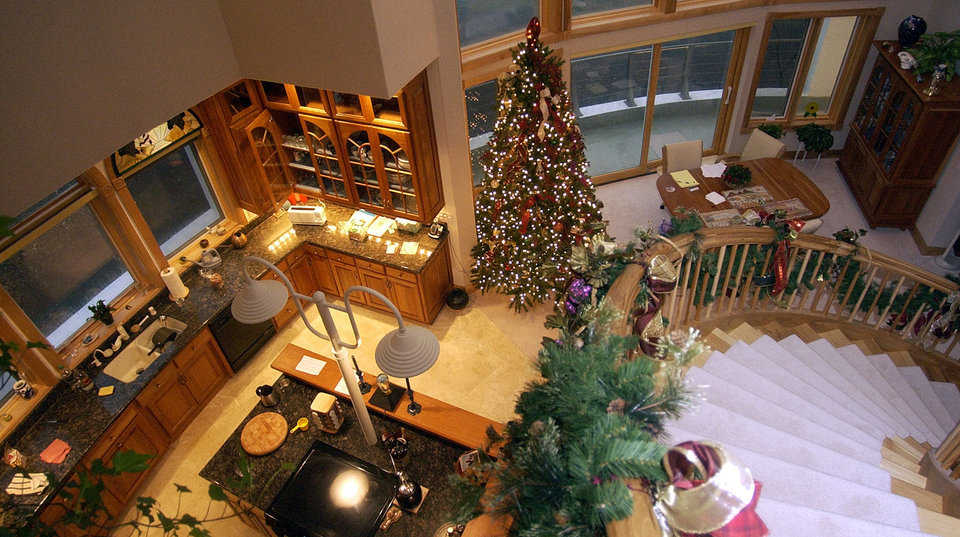
Third Level View — It overlooks the kitchen and dining area. The custom designed hickory staircase is the focal point of this dome.
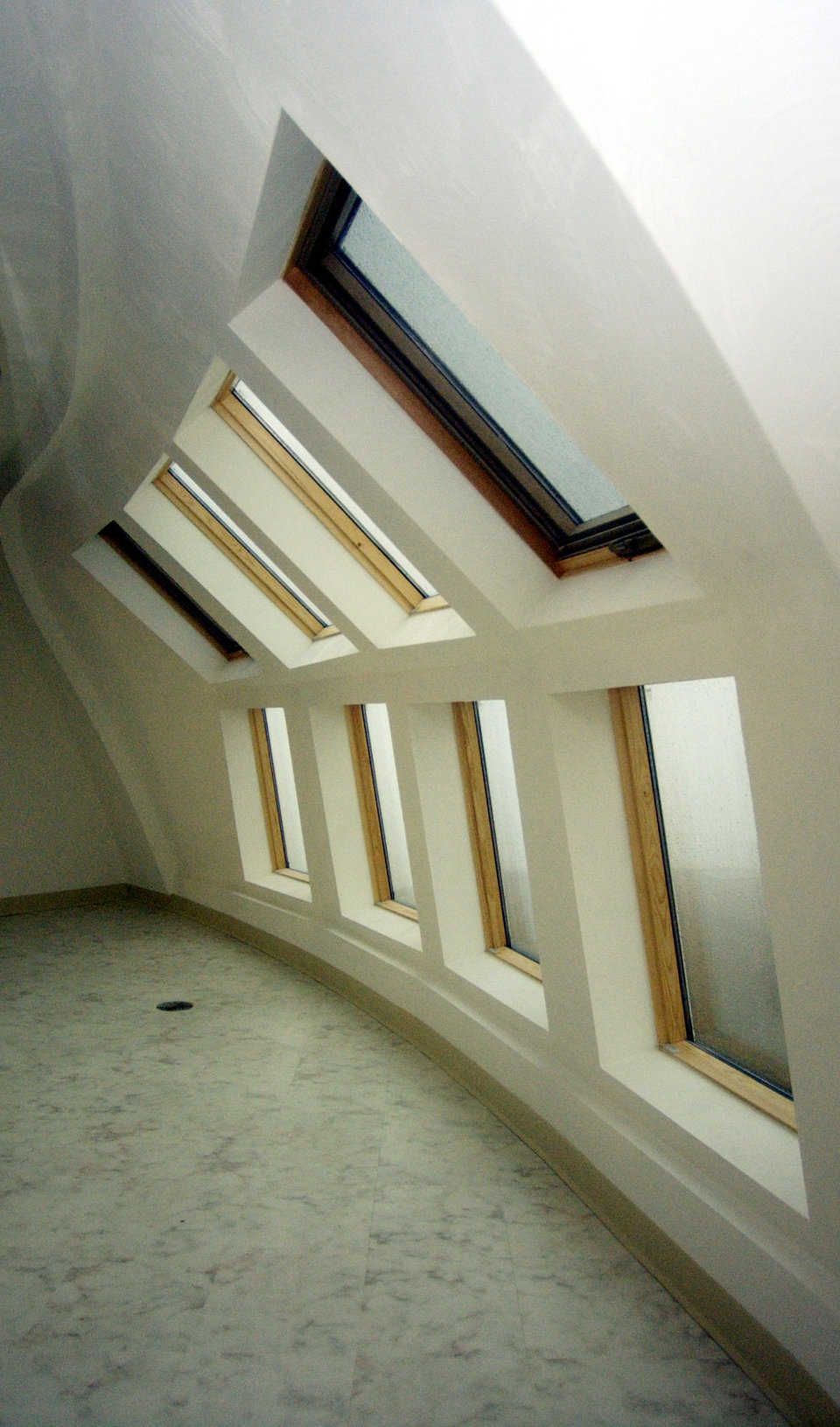
More Windows — The third floor also has many windows. They too provide a spectacular view of the area.
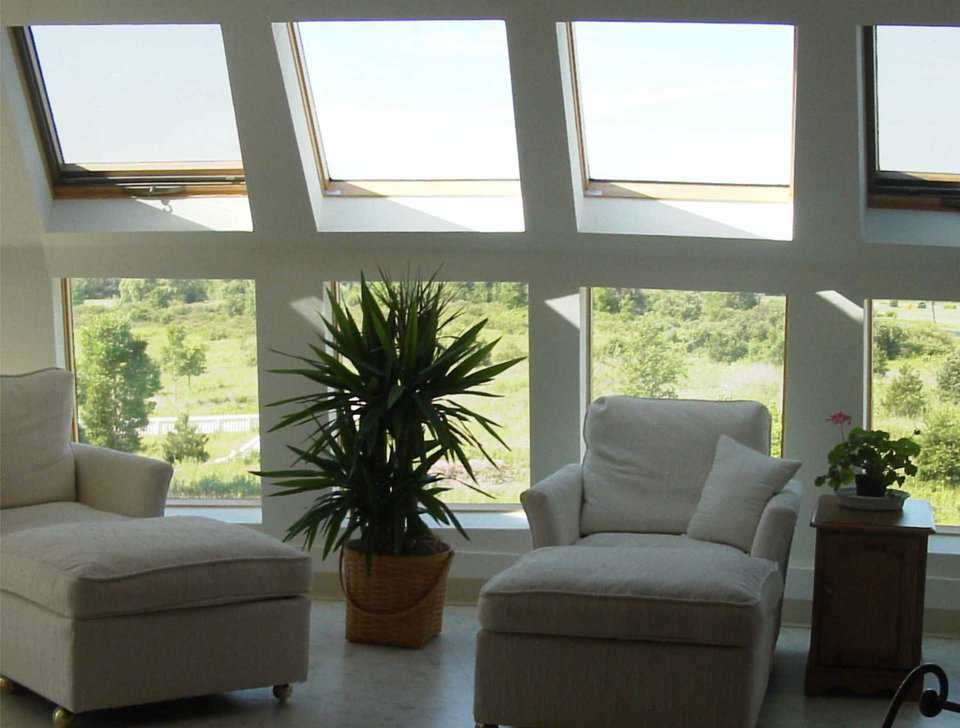
Sitting Area — This third-floor bedroom has a sitting area with a view.
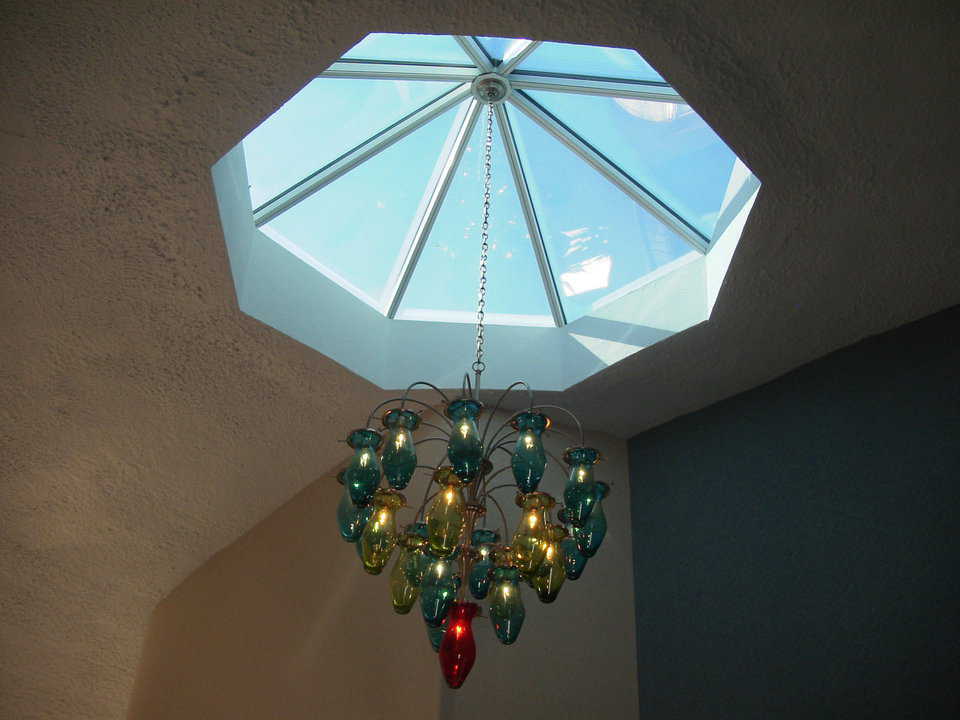
Unique Touches — A beautiful, glass chandelier hangs from a skylight.
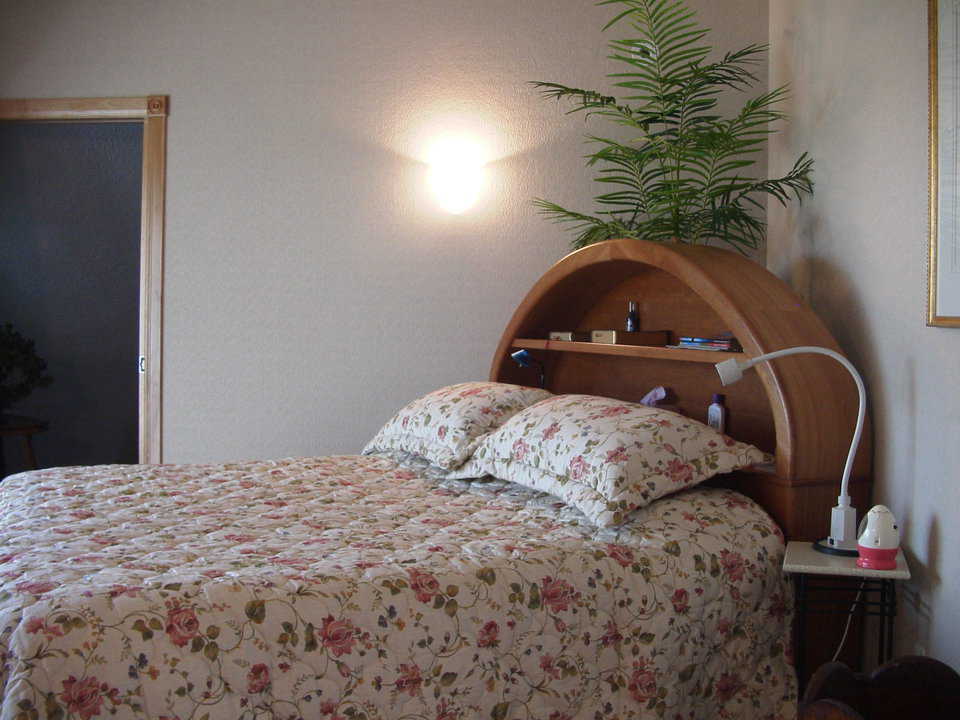
Master Bedroom — Barbara Stitt designed a massive, cherry-wood headboard for the master bedroom.
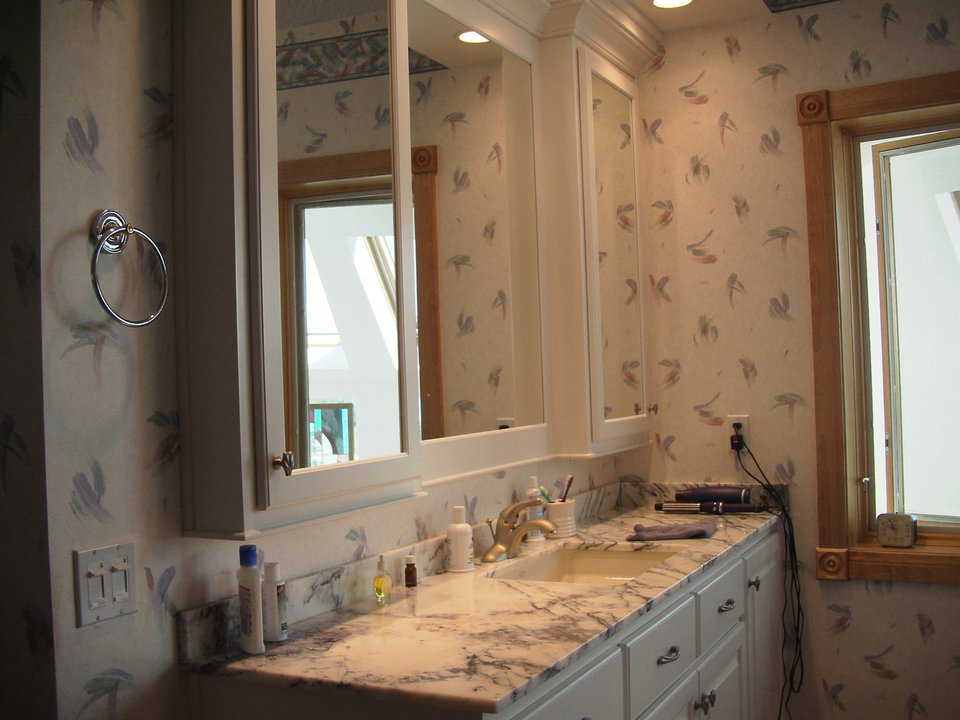
Twin Bathrooms — This dome-home includes his and her bathrooms, each with marble countertops.
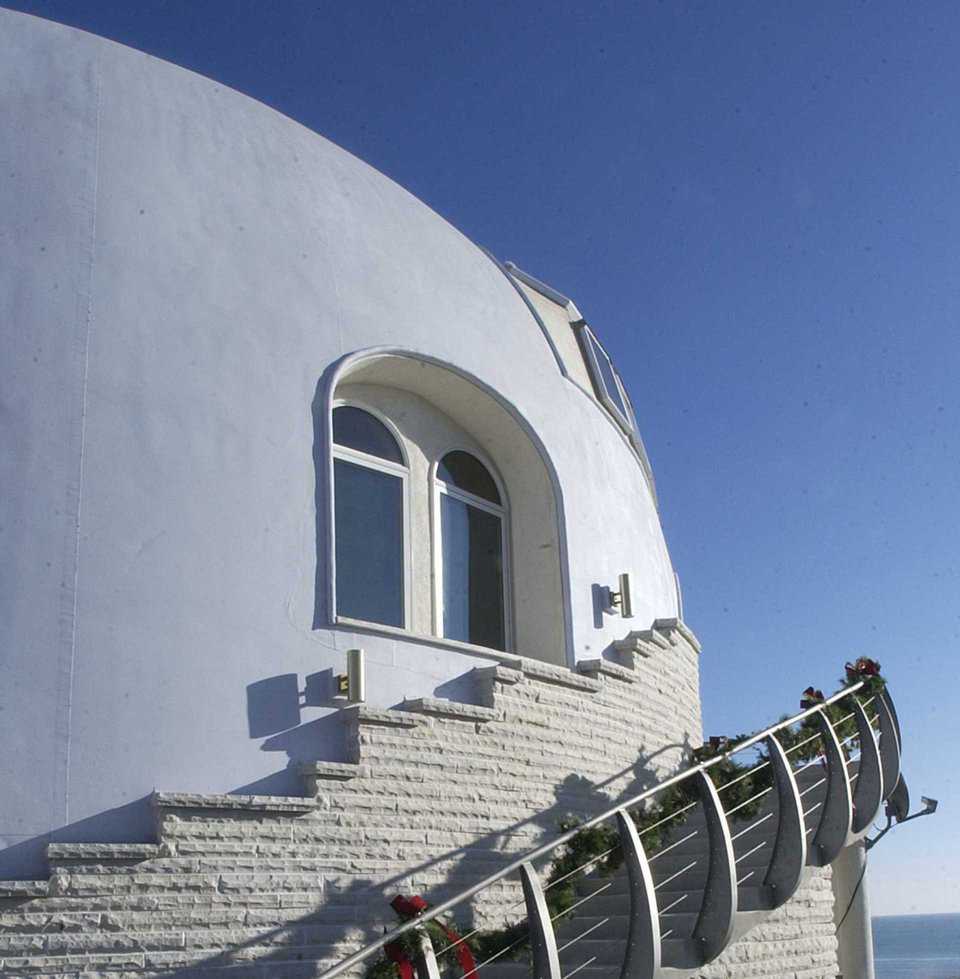
Outside Stairway — A curved, concrete stairway leads from the lowest level and ascends to the main living area. Limestone from a nearby quarry skirts the base of the dome.
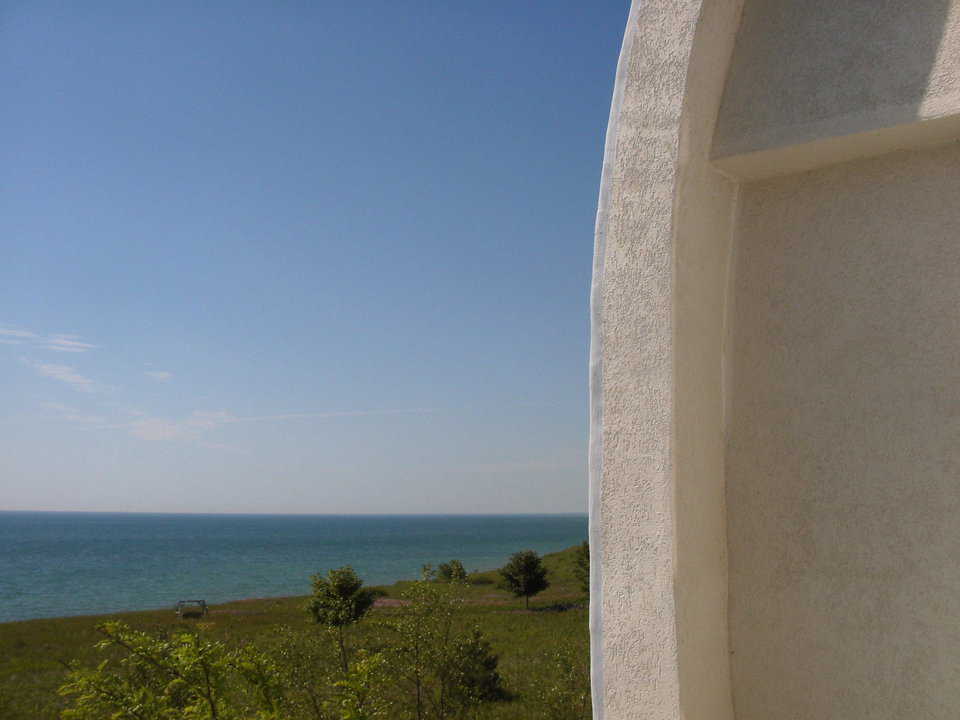
Balcony — Built off the dome’s third level, this balcony overlooks Lake Michigan.
